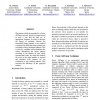79 search results - page 6 / 16 » Equivalent Number of Degrees of Freedom for Neural Networks |
MOBIHOC
2002
ACM
14 years 7 months ago
2002
ACM
In wireless sensor networks, energy efficiency is crucial to achieve satisfactory network lifetime. In order to reduce the energy consumption of a node significantly, its radio ne...
GRC
2010
IEEE
13 years 8 months ago
2010
IEEE
Inference of latent variables from complicated data is one important problem in data mining. The high dimensionality and high complexity of real world data often make accurate infe...
EUSFLAT
2007
13 years 8 months ago
2007
The patterns which are presented to a Fuzzy ARTmap network should be preprocessed in such a way that the data are of appropriate clearance. In order to decrease the degree of simi...
CORR
2010
Springer
13 years 5 months ago
2010
Springer
Interference alignment is a transmission technique for exploiting all available degrees of freedom in the symmetric frequency- or time-selective interference channel with an arbit...
NECO
2000
13 years 7 months ago
2000
The Bayesian committee machine (BCM) is a novel approach to combining estimators which were trained on different data sets. Although the BCM can be applied to the combination of a...

